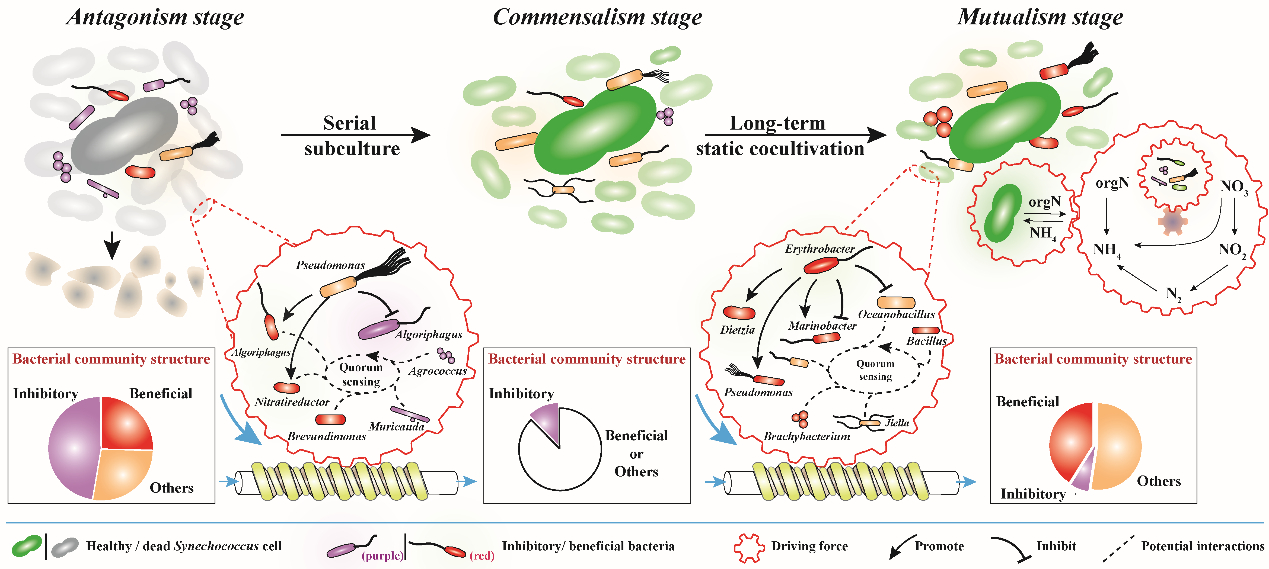How Do Heterotrophic Bacteria Improve Competitiveness of Synechococcus in Oceanic Carbon Fixation?
Picophytoplankton, mainly composed of Synechococcus and Prochlorococcus, are the most abundant photosynthetic autotrophs in the ocean, contributing up to 80% of the primary production (carbon fixation) in oligotrophic oceans.
Synechococcus, in particular, has obvious survival and competitive advantages in the ocean, making it ubiquitous from nutrient-rich coastal waters, oligotrophic oceans, to cold polar oceans.
In fact, Synechococcus cannot exist in isolation in the ocean, and it has always been inseparable from the microbial community. Researchers from the Qingdao Institute of Bioenergy and Bioprocess Technology (QIBEBT) of the Chinese Academy of Sciences (CAS) revealed how heterotrophic bacteria helps Synechococcus maintain its competitiveness and serve as one of the main forces of oceanic carbon fixation.
The related research results were published in Mbio on August 31.
The researchers investigated the dynamic relationship between Synechococcus sp. PCC7002 and a natural seawater bacterial community during a long-term cultivation process. They found that without any additional nutritional supplements for up to three years, a marine Synechococcus strain maintained vigorous vitality and high cell abundance. “The Synechococcus itself has no nitrogen fixation ability, but its culture medium always maintains a very high level of nitrogen nutrition. It implies that Synechococcus may coexist with the microbial community to establish a sustainable micro-ecosystem that can achieve nutritional self-sufficiency," said Prof. ZHANG Yongyu, a senior author of the study.
Meanwhile, the researchers observed that the relationship between Synechococcus and bacteria underwent a dynamic change from antagonism, commensalism, to mutualism relationship, after which Synechococcus could survive permanently without added nutrients.
The relationship change was attributed to the different effects of diverse bacterial members on Synechococcus and the ratio of beneficial to harmful bacteria. Different bacterial members also interacted with each other and drove a dynamic succession in the entire community structure that corresponded exactly to the shift in its relationship with Synechococcus.
In the final mutualism stage, a self-sufficient nitrogen cycle including nitrogen fixation, denitrification, and organic nitrogen degradation contributed to the healthy survival of Synechococcus for two years without exogenous nutrient supply. Metagenomic analysis and successful isolation of nitrogen-fixing bacteria indicated that the abundant nitrogen nutrition in the mutualism system may mainly come from the nitrogen-fixing ability of heterotrophic bacteria.
This capability of Synechococcus and heterotrophic bacteria towards self-sufficient mutualism suggests that heterotrophic bacteria may be an important support for Synechococcus growth especially in the oligotrophic regions of the ocean.
This study provides a new clue for understanding the wide distribution and competitive advantage of Synechococcus in the global ocean.

Dynamic changes in the relationship between Synechococcus and heterotrophic bacterial community under long-term cocultivation and the structural succession and functional metabolic characteristics of the bacterial community. (Image by ZHANG Zenghu)
(Text by ZHANG Zenghu)
Contact:
CHENG Jing
Qingdao Institute of Bioenergy and Bioprocess Technology, Chinese Academy of Sciences
Tel: 86-532-80662647/80662622
E-mail: chengjing@qibebt.ac.cn